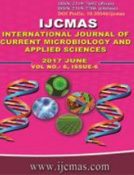


 National Academy of Agricultural Sciences (NAAS)
National Academy of Agricultural Sciences (NAAS)

|
PRINT ISSN : 2319-7692
Online ISSN : 2319-7706 Issues : 12 per year Publisher : Excellent Publishers Email : editorijcmas@gmail.com / submit@ijcmas.com Editor-in-chief: Dr.M.Prakash Index Copernicus ICV 2018: 95.39 NAAS RATING 2020: 5.38 |
Candidosis or Candidiasis caused by various species of Candida is the commonest fungal disease found in human beings and is among the four most common causes of nosocomial infections. Antifungal resistance poses a major public health concern. Lack of routine diagnostic testing for fungal diseases exacerbates the problem of antifungal drug empiricism. Aim: To study the Proportion, Speciation and Antifungal Resistance Pattern of the Candida Isolates in a tertiary care hospital of North Kerala. Materials and Methods: A retrospective study carried out based on review of records of 10803 patients from whom samples of blood, urine, sputum and exudates were collected and processed from January 2016 through December 2016 according to standard protocol. Data Analysis was done by using WHO net antibiotic resistance surveillance software; data was analyzed using EPI INFO 2013 software. Result: Out of the total of 10803 samples of blood, urine, sputum and exudates taken up for the study, culture was positive for growth of microorganisms in 3214 and Candida species was isolated in 132, giving an incidence of 4.1 % for Candidosis. The most vulnerable age group was above the age of 50 who constituted 80.3 %. C. albicans was the predominant species having recovered from 70(53%). Conclusion: Increasing rates of antimicrobial resistance pose a great problem in treating these infections; therefore early diagnosis and determination of Antifungal Resistance Pattern is mandatory.
 |
 |
 |
 |
 |